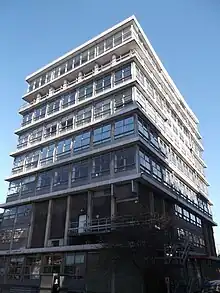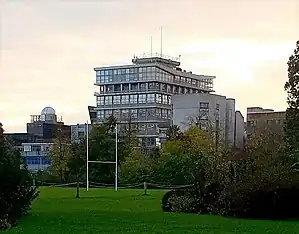 The Thom Building from the Banbury Road. | |
| Established | 1908 |
|---|---|
| Head of Department | Prof Ronald Roy |
| Location | , 51°45′35″N 1°15′34″W / 51.75972°N 1.25944°W |
| Campus | Keble Road Triangle |
| Website | www |

The Department of Engineering Science is the engineering department of the University of Oxford.[1] It is part of the university's Mathematical, Physical and Life Sciences Division. The department was ranked 3rd best institute in the UK for engineering in the 2021 Research Excellence Framework.[2]
It is principally located on a triangular plot formed by Banbury Road to the west, Parks Road to the east and Keble Road to the south. The main building is the tall 1960s Thom Building that dominates the local landscape, especially the view from the University Parks to the east. Further lower buildings have been added to the north since then. The department shares buildings with the Department of Materials.
Buildings
The department is based in the Thom Building, built in 1960, which houses two main lectures theatres, four floors of teaching, research and technical support laboratories, core administration offices and a student study area. The adjacent array of four interconnected buildings house departmental professor and postgraduate research space, some of which is shared with the Department of Materials. The department also maintains satellite facilities in a number of locations throughout the city. This includes the Old Road Campus Building, which houses the Institute of Biomedical Engineering, the Southwell Building (the Oxford Thermofluids Institute), Eagle House (the Oxford Man Institute for Quantitative Finance), the George Building (the Oxford Robotics Institute), and Begbroke Science Park (the Institute for Advanced Technology building).
History

The department was originally established in 1908 with the appointment of the first Professor of Engineering Science at Oxford, Frewen Jenkin,[3] grandfather of Lord Jenkin of Roding. The Jenkin Building is named after him. On 2 February 1909, the Honour School of Natural Science (Engineering Science) was formally instituted by a Statute of Oxford University.[3] The School was initially located at 6 Keble Road, on the south side of what is now known as the Keble Road Triangle, part of the Oxford University Science Area. The main part of the department has remained and expanded at this location to the present day.
The Thom Building, built in 1963, is named after Alexander Thom (1894–1985), a Scottish engineer who was also a professor of engineering at Oxford. The adjacent Holder Building followed in 1976.
The department celebrated its Centenary in 2008 and Lord Jenkin acted as its Patron.[4]
Spin-offs
There have been approximately 40 spin-offs from research done in the Department of Engineering Science. These companies operate in the medical, biotech, energy, transport, instrumentation, materials, nanotech, optics, robotics, and information technology spaces. The list includes PowderJect Pharmaceuticals, YASA, OrganOx, First Light Fusion, Oxsonics, Oxbotica, Sensyne Health, OxVent, Mind Foundry[5] and Opsydia.
Undergraduate study
The intake of students into the department is between 160 and 170 annually.[6] The department offers a general engineering course, where students only specialise in one of six areas in their third and fourth years of their Masters in Engineering degree (MEng). These specialisations are:[7]
- Biomedical engineering
- Chemical engineering
- Civil engineering
- Electrical engineering
- Information engineering
- Mechanical engineering
Students can also choose to follow an Engineering, Entrepreneurship and Management (EEM) pathway in the third and fourth years of their degree. This option is taught in coordination with the Saïd Business School.
Graduate study and research
The Department of Engineering Science carries out research in the following areas:
- Biomedical engineering
- Civil & offshore engineering
- Electrical & opto-electronic engineering
- Energy engineering
- Information, control & vision engineering
- Solid mechanics & materials engineering
- Thermo-fluids & turbomachinery
- Chemical and process engineering
The department is home to five research institutes:
- Oxford-Man Institute for Quantitative Finance (OMI) [8]
- Oxford e-Research Centre
- Oxford Thermofluids Institute
- Institute of Biomedical Engineering
- Oxford Robotics Institute
The research degrees offered by the department are MSc(R), DEng and DPhil.[9] The department has approximately 500 postgraduate research students.
Research Evaluation
The department was ranked 3rd among UK engineering departments in 2021 Research Excellence Framework (REF), having previously ranked 1st in 2014.
| Assessment Year | GPA | National Ranking |
|---|---|---|
| 2021[2] | 3.67 | 3 |
| 2014[2] | 3.53 | 1 |
Notable people
- Fellows of the Royal Society
- J. Michael Brady
- Alison Noble
- Philip Torr[10]
- Andrew Blake
- Roberto Cipolla
- Andrew Zisserman
- Brian Spalding
- Frederick Charles Frank
- Warren East, CEO of Rolls-Royce
- Hugh F. Durrant-Whyte
- Donal Bradley
- Charles Frewen Jenkin
- Richard Vynne Southwell
- Derman Christopherson
- David Clarke[11][12]
- Laszlo Solymar[13][14]
- Ted Paige
- Timoshenko Medal Recipients
- Heads of Department
- 1908-1929: Charles Frewen Jenkin
- 1929-1942: Richard Vynne Southwell
- 1945-1961: Alexander Thom
- 1961-1977: Douglas William Holder
- 1979-1989: Charles Peter Wroth
- 1989-1994: J. Michael Brady
- 1994-1999: David Clarke
- 1999-2004: Rodney Eatock Taylor [15]
- 2004-2009: Richard Darton
- 2009–2014: Guy Houlsby
- 2014–2019: Lionel Tarassenko
- 2019–present: Ronald A. Roy
- Alumni and researchers who have made significant contributions
- Rowan Atkinson, actor, comedian, and screenwriter
- Brian Bellhouse, founder of PowderJect
- Donal Bradley, pioneer in molecular electronic materials
- Brian Spalding, a founder of computational fluid dynamics.
- Constantin Cousssios, distinguished professor in biomedical engineering
- Hugh F. Durrant-Whyte, known for probabilistic methods for robotics
- Warren East, CEO of Rolls-Royce Holdings
- Frederick Charles Frank, theoretical physicist
- Shaukat Hameed Khan, optical physicist
- Paul Newman (engineer), founder of Oxbotica
- Ronald A. Roy, 65th George Eastman Distinguished Visiting Professor[16]
- Alison Noble, medical imaging researcher and first female Statutory Professor in Engineering at Oxford
- Janet Pierrehumbert, National Academy of Sciences, ISCA Medal for Scientific Achievement 2020
- Eleanor Stride, pioneer in drug delivery systems, Blavatnik Award for Young Scientists
- Anne Trefethen, computer scientist and professor of high-performance computing
- Andrew Zisserman, visionary pioneer in computer vision
- Leslie Fox, mathematician, doctorate student of Richard Vynne Southwell.
- Bill Bradfield, aviation engineer, and recipient of Edward Warner Award.
- Ann Nicholson, Dean in the Faculty of Information Technology of Monash University.
See also
References
- ↑ Alastair M. Howatson, Engineering Science at Oxford: A History, 2008.
- 1 2 3 "THE REF 2021".
- 1 2 Howatson, Alastair (2008). Mechanicks in the Universitie: A History of Engineering Science at Oxford. Department of Engineering Science, University of Oxford / The Holywell Press. ISBN 978-0-9526208-2-2.
- ↑ "Centenary of Engineering Science: Programme". Department of Engineering Science, University of Oxford. 2008. Archived from the original on 17 May 2008. Retrieved 8 December 2007.
- ↑ Foundry, Mind. "AI For High-Stakes Applications. Responsible, By Design". www.mindfoundry.ai. Retrieved 20 September 2023.
- ↑ "University of Oxford - Admissions Statistics - By Course". Tableau Software. Retrieved 18 August 2018.
- ↑ "MEng in Engineering Science — Department of Engineering Science". www.eng.ox.ac.uk. Retrieved 18 August 2018.
- ↑ "Introducing the Oxford-Man Institute of Quantitative Finance". oxford-man.ox.ac.uk. Retrieved 18 September 2018.
- ↑ "Graduate programmes — Department of Engineering Science". www.eng.ox.ac.uk. Retrieved 18 August 2018.
- ↑ "Royal Society". Royal Society.
- ↑ "Royal Society".
- ↑ "Department of Engineering Science website". Retrieved 21 November 2022.
- ↑ "IEEE Author Profile".
- ↑ "Royal Society".
- ↑ "SOUE News".
- ↑ "Info". www.americanrhodes.org.
External links
- Department of Engineering Science website
- Oxford University Engineering Society
- Society of Oxford University Engineers — the alumni society for Oxford engineering graduates
- SOUE News: One Hundred Years of Engineering Science at Oxford, 1908-2008
